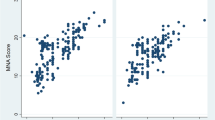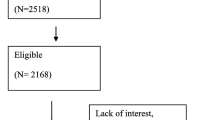Abstract
Background
Brazilian population has passed for a process of demographic transition throughout latest years, characterized for the increase of the elderly population. Malnutrition is a serious problem to frail elderly.
Objective
The objective of this study was o evaluate the risk of malnutrition among institutionalized elderly resident in municipal shelters in the city of Rio de Janeiro, Brazil, using the tool Mini Nutritional Assessment (MNA).
Design
344 institutionalized elderly aged over 60 years old were tested in a cross-sectional study using MNA. This tool classifies the nutricional status of the elderly in three groups: malnutrition (score < 17), risk of malnutrition (score 17–23,5) and well-nourished (score > = 24). Anthropometric measurements such as calf circumference (CC), mid-arm circumference (MAC) and Body mass index (BMI) were also evaluated. The variables were evaluated using the chi-square or A NOVA test. To correlate it was used Pearson’s Correlation Coefficient (r).
Results
Mean age were 75.4 (+− 9.4) years old. Most of the elderly were female gender (59.6%). According to MNA 8.3% were with malnutrition, 55.6% at risk of malnutrition and 36.1% well-nourished BMI classified 10.0% of the elderly as underweight. CC classified 10.0 % of them as inadequate in muscular mass. MNA was well correlated to BMI (r=0.41 2 p=0.000), age (r=−0.124 p=0.031), CC (r=0.399 p = 0.000) and MAC (r=0.391 p=0.000).
Conclusion
Risk of malnutrition was high among the institutionalized elderly from public shelters in Rio de Janeiro — Brazil. MNA is a useful diagnostic tool for the identification on the frail elderly at risk of malnutrition.
Similar content being viewed by others
References
Kalaehe, A; Veras, R; Ramos, L, O envelhecimento da população mondial um desafio novo. Rev. Saúde Pública, São Paulo, 1987, 21
Instituto Brasileiro de Geografia e Estatística (IBGE), Perfil dos Idosos Responsáveis pelo Domicílios no Brasil 2000/IBGE, Departamento de População e Indicadores Socials, Rio de Janeiro, 2002.
Andrews, G A.. Los desafíos del proeso de envejecimiento en las sociedades de hoy y del futuro. In: Encuentro Latmoamericano Y Caribe—O Sobre Las Petsonas De Edad, Santiago. Anais… Santiago: CELADE. 2000:247–256. (Seminarios y Confereneias-CEPAL, 2S, 1999.
WHO/NTMH/NPH Adive Ageing: A Policy Framework! WHO/NIMH/NPH Adive Ageing: A Policy Framework. Second United Nations World Assembly on Ageing, Madrid Spain April 2002.
Pereira, RS; Curioni, CC; Veras, R, Petfil Demográfico da População Idosa no Brasil e no Rio de Janeiro em 2002. Textes Sobre Envelhecimento, 2003; 6(1)
Guigoz Y, Vellas B, Garry P.J. Assessing the nutritional status of die elderly: the Mini Nutritional Assessment as part of the geriatric evaluation. Nutr Rev, 1996; 54. S59–S65
Rudman, D, Feller, AG, Protein-calorie undernutrition in the nursing home. J Am Geriatric Soc 1989; 37: 173–83
Kerstetter, JE, Holhausen, BA, Fitz, PA, Malnutrition in then institucionalized older adult. J Am Diet Assoc 1992; 92: 1109–16.
Sullivan DH, Patch GA, Walls RC, Lipschitz DA. Impact of nutrition status on morbidity and mortality in a select population of geriatric rehabilitation patients. Am J Clin Nutr 1990; 51:749–758.
Coiti MC, Guralnic LM. Serum albumin levels and physical disability as a predictor of mortality in older persons. JAMA 1994; 272: 1036–1042.
Ferguson RP, O’Connor P, Crasbtree Batchelor A, Miichell Y, Coppola D, Serum albumim and prealbumim as a predictor of clinical outcomes of hospitalized elderly nursing home residents. JAGS 1993; 41: 545–549.
Sullivan DH, Walls RC, Lipschitz DA, Protein-energy undernutritiion and the risk of mortality within 1 year of hospital discharge in a select population of geriatric rehabilitation patients. Am J Clin Nutr 1991; 53:599–605.
Engstrom EM (org.). SISVAN: Instrumento para o combate aos distúrbios nutricionais em serviços de saúde. 2a ed. Rio de Janeiro: FIOCRUZ, 2002.
Fialarone Singh MA, Bernstein MA, Ryan AD, O’neil EF, Clements KM, Evans WJ. The effect os oral nutritional supplements on habitual dietary quality arid quantity in frail elders. J Nutr Health Aging, 2000, 4(1):5–12.
Bleda MJ, Bolibar T, Pares R, Salva A: Reliability of the Mini Nutritional Assessment (MNA) in Institutionalized Elderly People The Journal of Nutrition Heath & Ageing, 2002, v. 6, n 2, Barcelona, Spain.
Haschke F. The New Nestlé Clinical & Performance Nutrition Workshop series INI: Vellas, Bruno, Garry, Philip J., Guigoz, Yves Mini Nutritional Assessment (MNA): Research and practice in the elderly, Ed Karger v.1, p.1–2, Switzerland, 1999.
Coelho MASC, Pereira RS, Coelho KSC. Antropometiia e Composição Corporal em Idosos. In: Frank & Soares. Nutrição no Envelhecer. Editora Atheneu, Rio de Janeiro, 2001.
Chumlca WC; Baumgardner RN. Status of anthropometry and body composition data in elderfy subjects. Am J Clin Nutr v.50. p.1158–1166, 1989.
Kuczmarski RJ. Need for body composition information in elderly subjects. Am J Clin Nutr v.50. p. 1150–7, 1989.
Rosenberg IH et al: Folate Nutrition in the Elderly. Am J Clin Nutr v. 36 p. 1060, 1992.
Guigoz Y, Vellas B, Garry PJ. Mini Nutritional Assessment: a practical tool for grading the nutritional state of the elderly patients. Facts Res G erontol 1994: (suppl 2): 15–60.
Guigoz Y., Vellas B., The Mini Nutritional Assessment (MNA) for grading de nutritional stale of the elderly patients: Presentalion of the MNA, Hisiory and Validation Nestlé Nutriti on Workshop Serie Clinical and Performance Programme, 1999(1): 3–12.
WHO — World Health Organization. Physical Status: The use and interpretation of anthropometry. Geneve: World Health Organization, 1995.
Altaian DG. Practical Statistics for Medical Research, Chapman & Hall, London, 1991.
Chandra RK, 1992. Nutrition and immunoregulation. Significance for host resistance to tumours and infectious diseases in hum arts and rodents. Journal of Nutrition. 122(Sup.):754–757.
James WP, Nefeon M, Ralph A, Leather S.. Socio-economic determinante of health. The contribution of inequalities in health. BMJ, 1997 (314):1545–1549.
Bauder F, Scribans C, Duberaet CE, Capdupuy C. Evaluation of the nutritional status of patients over 60-year admitted in a hematology department using the Mini Nutritional Assessment (MNA).A single centre study of 120 cases. The Journal of Nutrition Health and Ageing, 2003, 7(3); 179–182.
Sullivan DH. Risk factors for early hospital readmission in a select population of geriatric rehabilitation patients: The significance of nutritional status. Journal of the American Geriatric Society, 1992 (40): 792–798.
Vellas BJ, Hunt WC, Romero O, Koehler KM, Baumgartner RN, Garry PJ. Changes in nutritional status and patterns of morbidity among free-living elderly peisons: A 10-year longitudinal study. Nutrition, 1997 (13):515–519.
Barreto SM; Passos VMA, Lima-Costa MFF. Cad. Saúde Pública, Rio de Janeiro. 2003, 19(2):605–612.
Beck AM, Ovesen L, Schroll M. A six months’ prospective follow-up of 65 +−y-old patients from general practice classified according to nutricional risk by the Mini Nutritional Assessment. Eur J Clin Nutr, 2001 (55): 1028–1033.
Tavares EL, Anjos LA Perfil antropométrico da populaçào idosa brasileira Resultado da Pesquisa Nacionaî sobre Saúde e Nutriçào. Caderno de Saúde Pública, 1999, 15(4).
Kuczmarski RJ et al. Increasing prevalence of overweight among U.S. adults. The National Health and Nutrition Examination Surveys, 1960 to 1991. Journal of the American Medical Association 1994 (272):205–211.
Noppa, H.M. Anderson, M., Bergteson, G., Bruce, A., & Isaksson, B. (1980). Longitudinal Study of Anthropometric Data and Body Composition: The Population Study of Women in Gotebeig, Sweden Am. J. Clin Nutr. 33: 155–162.
Steen, B., Isaksson, B. & Suanborg A. Body Composition at 70 and 75 Years of Age. A longitudinal population study. J. Clin Exp. Geront. 1979 (1): 185–200.
Frisancho, A.R. New Noms of Upper Limb Fat and Muscle Areas For Assessment of Nutritional Status. Am. J. Clin Nutr.. 1981 (34): 2540.
Burr, B. and Phillips, K (1984). Anthropometric Norms in The Elderly. Br. J. of Nutr. 51: 165. Forbes, G.B. (1976). The Adult Decline in Lean Body Mass. Hum. Biol. 48:161–166.
Deurenberg, P., Vander Kooy, K, Hufshof T & Evers P.. Body Miss Index as a Measure of Body Fatness in The Elderly. Eu. J. Clin. Nutr., 1989 (43): 231–236.
Coelho MASC. Perfil do Estado Nutricional e de Saúde de Idosos Residentes em asilos do Município do Rio de Janeiro. Relatório apresentado à FAPERJ e FUJB, 2002.
Author information
Authors and Affiliations
Corresponding author
Rights and permissions
About this article
Cite this article
Pereira Machado, R.S., Coelho, M.A.S.C. Risk of malnutrition among Brazilian institutionalized elderly: A study with the Mini Nutritional Assessment (MNA) questionnaire. J Nutr Health Aging 15, 532–535 (2011). https://doi.org/10.1007/s12603-011-0059-8
Received:
Accepted:
Published:
Issue Date:
DOI: https://doi.org/10.1007/s12603-011-0059-8




